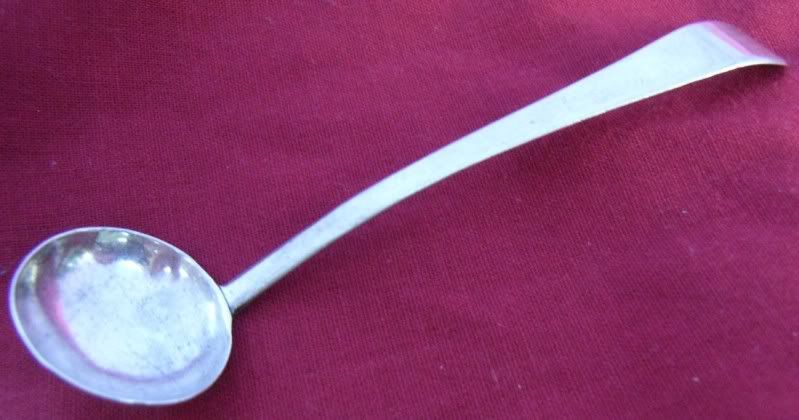Miles






It is the opinion of The Birmingham Assay Office that the original hallmark on the spoon has been overstamped with a maker's mark of "L&R" and a date letter. The original mark is extremely worn in comparison to this maker's mark and the date letter, and, further more, there is no maker's mark registered at The Birmingham Assay Office for the date of 1806. It is our judgement, therefore, that the mark is counterfeit.
We have delt with this in accordance with the law relating to hallmarking. Under Section 7 of the Hallmarking Act (1973), the Assay Offices of Great Britain are required to cancel counterfeit marks. We have now cancelled the marks on the spoon...

7 Treatment by assay offices of unauthorised marks
(1)Subject to subsection (2) of this section, an assay office may at their discretion cancel, or obliterate any mark of the character of a hallmark (whether appearing to be an approved hallmark or to be a mark which in the opinion of the assay office is likely to be confused with such a hallmark) which an article coming into their custody or possession bears and which the assay office are satisfied–
(a)has not been struck thereon by an assay office according to law; or
(b)is not a true description because the article appears to have been the subject of an improper alteration.
(2)Notwithstanding anything in any enactment, an assay office shall not, otherwise than by leave of the owner or other person appearing to have the control of any article, obliterate any ancient mark but shall cancel the same in a manner authorised under subsection (3) of this section.
(3)The Council may issue directions to assay offices as to the manner in which an ancient mark may be cancelled under the last foregoing subsection.
(4)If it be proved that an assay office have–
(a)cancelled, or obliterated any mark (as described in subsection (1) of this section), which has been struck by an assay office according to law on an article which has not been the subject of an improper alteration; or
(b)obliterated any ancient mark upon an article,
the assay office (but not any other person) shall be liable in damages to any person interested in the article.
(5)In any action brought against an assay office in pursuance of subsection (4) of this section it shall be a defence for them to prove that they had reasonable cause to believe that the circumstances specified respectively in paragraphs (a) or (b) of that subsection did not exist.
(6)It shall be an offence for any person knowingly or any dealer to supply or offer to supply any article bearing any mark of the character of a hallmark and which under subsection (1) of this section may, if the article is in the possession of an assay office, be cancelled, obliterated or defaced, unless the article has been first submitted to an assay office to enable them at their discretion so to cancel, obliterate or deface that mark.
(7)In this section “ancient mark” means a mark of the character of a hallmark appearing to an assay office to have been struck or incorporated before 22nd December 1854 (whether or not by an assay office according to law at the time of its marking or incorporation) upon or into an article which has not since been the subject of any improper alteration.

How dangerous is that? Your piece was defaced only because of what it was not, no regard was given to what it could have been or what it could have taught us. As a group, these marks were unknown and uncatalogued, an anomaly far more interesting than the dime a dozen makers marks already identified. These marks comprised raw data, as such they would have had significant value to current and future silver scholars and researchers. To know they were destroyed for no better reason than 'they ain't Birmingham' is both saddening and frightening.(whether appearing to be an approved hallmark or to be a mark which in the opinion of the assay office is likely to be confused with such a hallmark)
I do not criticize them for attempting to protect their own interests, I criticize them for the method in which they chose to do so, and that is most certainly just....but to criticise the assay offices for protecting their interests is surely unjust.

